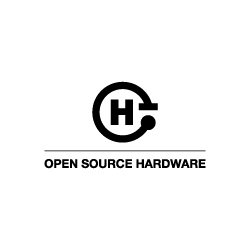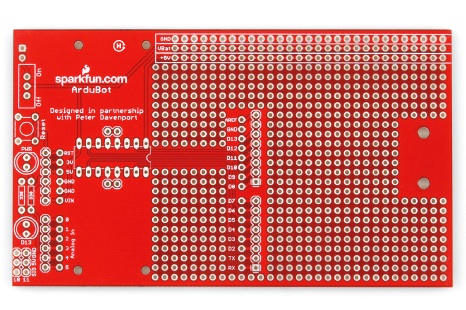Back in October, we posted about the Open Source Hardware Summit - a meeting of individuals who are in support of the "open source hardware movement." In addition to Windell Oskay, David Mellis, and Phillip Torrone, SparkFun CEO and Founder Nate Seidle is one of a small group of people that have been working to make OSHW a mainstay in the embedded electronics community. One of the biggest difficulties in bringing OSHW mainstream has been that there was never really a concrete definition of what open source hardware is - until now, that is.


Two of the proposed new Open Source Hardware logos.
Just this week, the first definition of open source hardware was released. While the definition itself is a little long to hash out here, you can read the entire definition at this page. However, here is a quick summation of the basics of OSHW from the Open Source Hardware Statement of Principle:
"Open source hardware is hardware whose design is made publicly available so that anyone can study, modify, distribute, make and sell the design or hardware based on that design. The hardware's source, the design from which it is made, is available in the preferred format for making modifications to it. Ideally, open source hardware uses readily-available components and materials, standard processes, open infrastructure, unrestricted content, and open-source design tools to maximize the ability of individuals to make and use hardware. Open source hardware gives people the freedom to control their technology while sharing knowledge and encouraging commerce through the open exchange of designs."

Once a logo is decided on, it will appear on our open source PCBs - like the ArduBot.
SparkFun Senior Graphic Designer David (he of Antimov character fame) has been working to create a logo for OSHW. While the exact logo has not been decided on yet (there are several different logos under consideration), you will probably start seeing an OSHW logo pop up in various places - including on many of the PCBs that SparkFun sells. If a product is open source, it basically means you are free to take it, change it, and sell it for a profit - as long as you give us attribution. There is more to it, but that is where this definition comes in.
We have not yet developed a specific license for OSHW, but it is in the process and should be released shortly. As it stands now, this definition is a great first-step towards bringing open source hardware to the frontlines.







I'm very proud of this, and I feel that it's time to get more involved. This will save us from the Hell of proprietary systems and designs that a lot of us are forced to use.
Whoa whoa whoa! So, to be fair, yes, Eagle is closed source, but I don't think that either of the open source alternatives you've noted here are even close to ready for commercial development from what I've seen. That being said I would have to play with them for a lot longer than I have to confirm that. It's nice to have these in the community, and if they get good enough that they're running in commercial environments then all the better. But for now, sparkfun is providing these schematics through a commercial product which at least has the benefit of outputting to a program which can run for free.
As for PIC: You can download and compile the dsPIC and PIC24 compiler source from Microchip and compile it yourself! It's just gcc with modifications! There are lots of people who have done it before and they have left guides.
There are also open source assemblers for the PIC16 and below (or at least there is 1, but everyone uses it). You may say "I want to make C code for my pic16f88!" but the honest answer is that the midrange and low-end chips aren't designed for compiled C! Getting compiled code to run on these involves doing crazy code compilation acrobatics and makes for inefficient and silly code.
The PIC18 line is the PIC16 line with structures appended onto it to make C code function at least tolerably, but it's a hack. The 18 compiler that they offer they made themselves, but I don't really like the 18 line so I generally don't talk about it. Yes it's nice to have C, and the USB chips are certainly tempting, but I'll use the PIC24/dsPIC lines before the 18.
I'm curious (aside from PICs) which programs you're talking about without good compiler support. The big three (in my mind) are ATmel, PIC, and ARM. Pretty much all the ARMs are supported by gcc, ATmel too. Newer PICs run with GCC as well.
I think you mean "bigger PICs". The 8 bit PICs are a disaster to target with any high level language. 8 bit AVR's have very good gcc support.
You need to take a look at either gEDA or KiCAD. There are commercial and many high-end research projects that use gEDA. I use gEDA. Even my hobby projects would not fit in the free version of Eagle, and besides, the free Eagle license precludes making any kind of money off your board (for instance, sharing it through BatchPCB, or selling a few on your hobby web site.) gEDA supports boards bigger than any PCB house's maximum panel, and arbitrarily many layers (although you will need to build from source if you want more than 32 layers.) I don't use KiCAD, so I can't comment -- I want to give it a serious evaluation but don't have the time right now. gEDA has three weaknesses, IMO, 1) inner layer annulus in footprints is the same as exterior layer annulus, and 2) the library situation is spotty, 3) the footprint definition lacks fine-grained control over the paste stencil layer.
Eagle has no place in Open Hardware, IMO. That evil needs to be rooted out. Go read the license for free Eagle carefully, and see if you agree.
I don't think the compiler matters much because I am not an open source idealist, as long as the compiler is unrestricted that is fine. See my post below about this as well...
The focus on using Eagle in the community is a very very bad thing.
No need to make your own OSHW logos:
http://nbitwonder.com/blog/2011/02/11/open-source-hardware-eagle-symbols/
You can grab em out of our eagle library.
Isn't open source grand? :-P
You can check out my OSHW logo in Photoshop too...
I was picturing something like an open padlock with the padlock body being drawn in PCB traces.
Like this one?
That was inverted from what I had in mind, but it is simple, nice and very iconic. It also has an appealing insect quality. That's a huge improvement!
I like this logo better than any other, However the pad lock should be more open than what it is.
Agreed, if you look it also seems to have a curve to it at the end.
I really like this logo. It just nails what we're all going for. Maybe move some of the traces on and some off the padlock?
So, is the implication here that Sparkfun's excellent EAGLE library will soon be ported to a tool that is ACTUALLY open source?
Because if that's the implication, I see great cause for celebration! If not... well, back to the drawing board, I guess.
Let's hope Sparkfun understands this concept.
As an avid open source software community member for well over ten years, I'm stoked to see hardware coming along. When I first heard about Arduino I was instantly intrigued.
I'm not working on my first project and can't wait to share my experience with the rest of the community. Viva la open source.
I'm unconvinced that this actually does anything useful.
Also, calling it the first definition would be overstating things quite a bit.
Open source hardware is such a idea. I think its impossible to create the perfect design with only one persons perspective anyway. It's good to see a company become so successful and still give back to the community in a way that isn't completely for its own self interest.
Open hardware shouldn't be done using Eagle. By using 'free' Eagle you aren't in principle allowed to 'sell' it so you can't really license it however you want.
Sparkfun needs to move away from Eagle:
"If you earn (or save) money by using the Freeware version of EAGLE Light, you have to register it."
Sparkfun states the goal of open hardware is:
"If a product is open source, it basically means you are free to take it, change it, and sell it for a profit"
Well you can do everything but the last one with Eagle free.
Everyone would be much better off if the effort of the community was put behind something truly non-commercial like KiCAD or gEDA [I use the former]. While there is absolutely nothing wrong with free Eagle for hobby use, the more and more the community supports it the more and more you are pushing uses to use something that is not free when they outgrow its basic features.
I use gEDA, and I suspect the main barrier to wider adoption of KiCAD is the same as with gEDA -- libraries. This is where support from organizations like SparkFUN could make a huge difference. If they made available a symbol and a footprint to go with the devices they offer it would make a huge difference.
The OpenSource Helicopter Pad Initiative?
I much prefer the Lock with pads, though I would turn the hasp away from the lock to show unlockedness.
Version 1.1 is already out... good start everyone!
Cool!
I am a hardware from chinese.
Thank you! sparkfun.
Very cool. Now we need an open source hardware repository for storing all the files (or is there one out there?). I use Google's project hosting for now... maybe that'll be good enough.
It's been really great to see the open source hardware spec mature so quickly over the past few months.
But I think it's a real shame that it seem to focus so heavily on electronics. Physical Open Source Things don't need to have any electric components at all. There are tons of areas that can benefit from shared specifications.
And all but one of the logos are references to electronics. (And that one is... not inspiring.) I'd love to see someone design a logo that more inclusive and reflects the fill possibilities of OSH.
I think what you're seeing is a function of community size and involvement; the hobby electronics community, and particularly the "open" community, is significantly larger that the organized open community of physical makers. Low-cost 3D printing and CNC tools are improving that, but it's still an emerging community.
From looking through the OpenHardwareSummit website and forum, I don't think the lack of attention to physical makers (vs. electronics) is an intentional snub; it's just a natural bias of the experiences of those who've chosen to make themselves involved in the process. If you work on electronics all day, you might not feel as though you're in a position to speak about the particular needs of the 3D printing community, for example.
Is it a pad with a track connected to half of a capacitor symbol, forming an open circuit? I like it because it's easy to draw and thus represent.
I think there is a typo. That is ArduBot not the Ardupilot in the picture.
Right you are - thanks Peter!
It's funny when you read news about open source hardware and there is a board that you helped design used as an example.
So...A nose ring with an "H" centered in it?
When is SparkFun going to start selling these open-hardware nose rings I keep hearing about? I want mine with a banana plug, for grounding to my antistatic workstation.
I like the (H) logo. It looks good in one color, reduces legibly, and is sufficiently generic to include non-electronic items. It's also not jagged. And it lends itself to ASCII representation: (H).
If we see only a capacitor symbol, I think that reflects our tribal cognitive bias. Would a mechanical engineer, chemist, or physicist immediately think of a capacitor and feel excluded when presented with the logo? I think not. Open hardware (H) logo for the win!
This is a great movement and I hope to be a part of it, in some manner.
As for the logo, it looks like there should be a C or G in the name, given the outer ring. If it is supposed to represent an O, maybe the "pads" should be either on the top or bottom. Otherwise, looks good!